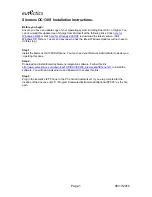
Fabric OS Administrator’s Guide
51
53-1002745-02
Device login
1
Device login
A device can be storage, a host, or a switch. When new devices are introduced into the fabric, they
must be powered on and, if a host or storage device, connected to a switch. Switch-to-switch logins
(using the E_Port) are handled differently than storage and host logins. E_Ports exchange different
frames than the ones listed below with the Fabric Controller to access the fabric. Once storage and
host devices are powered on and connected, the following logins occur:
1. FLOGI—Fabric Login command establishes a 24-bit address for the device logging in, and
establishes buffer-to-buffer credits and the class of service supported.
2. PLOGI—Port Login command logs the device into the name server to register its information
and query for devices that share its zone. During the PLOGI process, information is exchanged
between the new device and the fabric. Some of the following types of information exchanges
occur:
•
SCR—State Change Registration registers the device for State Change Notifications. If a
change in the fabric occurs, such as a zoning change or a change in the state of a device
to which this device has access, the device receives a Registered State Change
Notification (RSCN).
•
Registration—A device exchanges registration information with the name server.
•
Query—Devices query the name server for information about the device it can access.
Principal switch
In a fabric with multiple switches, and one inter-switch link (ISL) exists between any two switches, a
principal switch is automatically elected. The principal switch provides the following capabilities:
•
Maintains time for the entire fabric. Subordinate switches synchronize their time with the
principal switch. Changes to the clock server value on the principal switch are propagated to all
switches in the fabric.
•
Manages domain ID assignment within the fabric. If a switch requests a domain ID that has
been used before, the principal switch grants the same domain ID unless it is in use by another
switch.
E_Port login process
An E_Port does not use a FLOGI to log in to another switch. Instead, the new switch exchanges
frames with the principal switch to establish that the new switch is an E_Port and that it has
information to exchange. If everything is acceptable to the principal switch, it replies to the new
switch with an SW_ACC (accept) frame. The initializing frame is an Exchange Link Parameters (ELP)
frame that allows an exchange of parameters between two ports, such as flow control,
buffer-to-buffer credits, RA_TOV, and ED_TOV. This is not a negotiation. If one or the other port’s link
parameters do not match, a link does not occur. Once an SW_ACC frame is received from the
principal switch, the new switch sends an Exchange Switch Capabilities (ESC) frame. The two
switches exchange routing protocols and agree on a common routing protocol. An SW_ACC frame is
received from the principal switch and the new switch sends an Exchange Fabric Parameters (EFP)
frame to the principal switch, requesting principal switch priority and the domain ID list.
Buffer-to-buffer credits for the device and switch ports are exchanged in the SW_ACC command
sent to the device in response to the FLOGI.
Summary of Contents for Fabric OS 7.1.0
Page 1: ...53 1002745 02 25 March 2013 Fabric OS Administrator s Guide Supporting Fabric OS 7 1 0 ...
Page 24: ...24 Fabric OS Administrator s Guide 53 1002745 02 ...
Page 28: ...28 Fabric OS Administrator s Guide 53 1002745 02 ...
Page 32: ...32 Fabric OS Administrator s Guide 53 1002745 02 ...
Page 42: ...42 Fabric OS Administrator s Guide 53 1002745 02 ...
Page 132: ...132 Fabric OS Administrator s Guide 53 1002745 02 Frame Redirection 4 ...
Page 194: ...194 Fabric OS Administrator s Guide 53 1002745 02 Ports and applications used by switches 6 ...
Page 254: ...254 Fabric OS Administrator s Guide 53 1002745 02 Brocade configuration form 8 ...
Page 274: ...274 Fabric OS Administrator s Guide 53 1002745 02 Validating a firmware download 9 ...
Page 302: ...302 Fabric OS Administrator s Guide 53 1002745 02 Creating a logical fabric using XISLs 10 ...
Page 344: ...344 Fabric OS Administrator s Guide 53 1002745 02 Concurrent zone transactions 11 ...
Page 374: ...374 Fabric OS Administrator s Guide 53 1002745 02 Setting up TI over FCR sample procedure 12 ...
Page 462: ...462 Fabric OS Administrator s Guide 53 1002745 02 ...
Page 490: ...490 Fabric OS Administrator s Guide 53 1002745 02 Ports on Demand 18 ...
Page 498: ...498 Fabric OS Administrator s Guide 53 1002745 02 Supported topologies for ICL connections 19 ...
Page 626: ...626 Fabric OS Administrator s Guide 53 1002745 02 Preparing a switch for FIPS B ...
Page 630: ...630 Fabric OS Administrator s Guide 53 1002745 02 Hexadecimal Conversion C ...
Page 666: ...666 Fabric OS Administrator s Guide 53 1002745 02 ...
















































